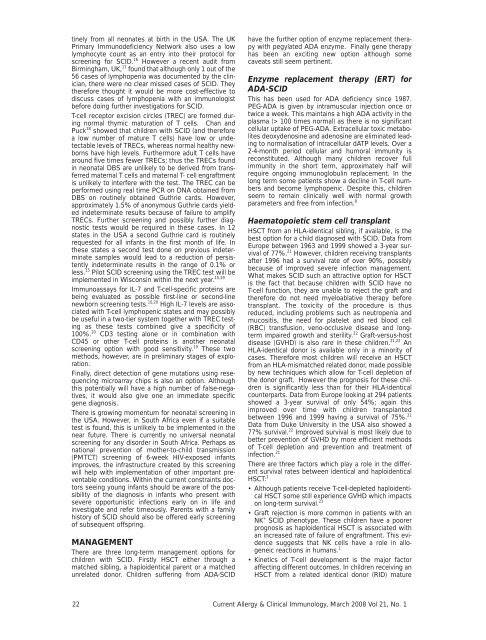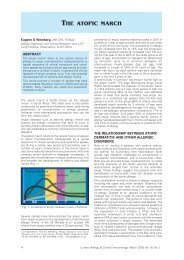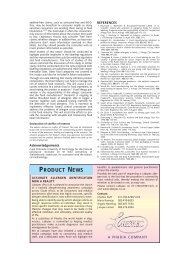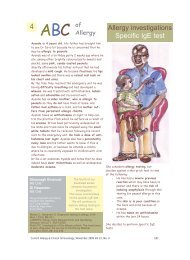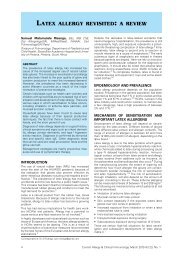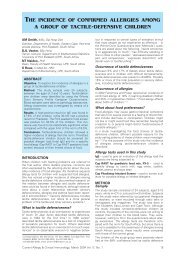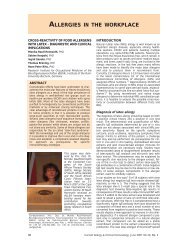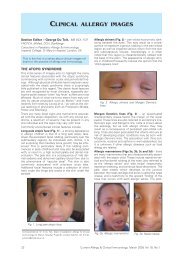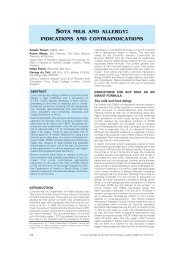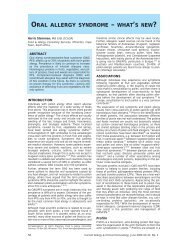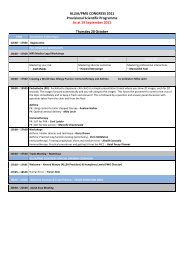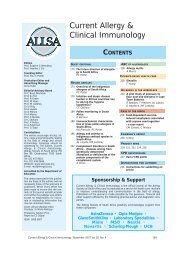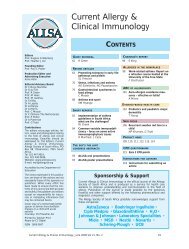Current Allergy and Clinical Immunology - March 2008
Current Allergy and Clinical Immunology - March 2008
Current Allergy and Clinical Immunology - March 2008
You also want an ePaper? Increase the reach of your titles
YUMPU automatically turns print PDFs into web optimized ePapers that Google loves.
tinely from all neonates at birth in the USA. The UKPrimary Immunodeficiency Network also uses a lowlymphocyte count as an entry into their protocol forscreening for SCID. 16 However a recent audit fromBirmingham, UK, 17 found that although only 1 out of the56 cases of lymphopenia was documented by the clinician,there were no clear missed cases of SCID. Theytherefore thought it would be more cost-effective todiscuss cases of lymphopenia with an immunologistbefore doing further investigations for SCID.T-cell receptor excision circles (TREC) are formed duringnormal thymic maturation of T cells. Chan <strong>and</strong>Puck 18 showed that children with SCID (<strong>and</strong> thereforea low number of mature T cells) have low or undetectablelevels of TRECs, whereas normal healthy newbornshave high levels. Furthermore adult T cells havearound five times fewer TRECs; thus the TRECs foundin neonatal DBS are unlikely to be derived from transferredmaternal T cells <strong>and</strong> maternal T- cell engraftmentis unlikely to interfere with the test. The TREC can beperformed using real time PCR on DNA obtained fromDBS on routinely obtained Guthrie cards. However,approximately 1.5% of anonymous Guthrie cards yieldedindeterminate results because of failure to amplifyTRECs. Further screening <strong>and</strong> possibly further diagnostictests would be required in these cases. In 12states in the USA a second Guthrie card is routinelyrequested for all infants in the first month of life. Inthese states a second test done on previous indeterminatesamples would lead to a reduction of persistentlyindeterminate results in the range of 0.1% orless. 15 Pilot SCID screening using the TREC test will beimplemented in Wisconsin within the next year. 15,19Immunoassays for IL-7 <strong>and</strong> T-cell-specific proteins arebeing evaluated as possible first-line or second-linenewborn screening tests. 15,20 High IL-7 levels are associatedwith T-cell lymphopenic states <strong>and</strong> may possiblybe useful in a two-tier system together with TREC testingas these tests combined give a specificity of100%. 20 CD3 testing alone or in combination withCD45 or other T-cell proteins is another neonatalscreening option with good sensitivity. 19 These twomethods, however, are in preliminary stages of exploration.Finally, direct detection of gene mutations using resequencingmicroarray chips is also an option. Althoughthis potentially will have a high number of false-negatives,it would also give one an immediate specificgene diagnosis.There is growing momentum for neonatal screening inthe USA. However, in South Africa even if a suitabletest is found, this is unlikely to be implemented in thenear future. There is currently no universal neonatalscreening for any disorder in South Africa. Perhaps asnational prevention of mother-to-child transmission(PMTCT) screening of 6-week HIV-exposed infantsimproves, the infrastructure created by this screeningwill help with implementation of other important preventableconditions. Within the current constraints doctorsseeing young infants should be aware of the possibilityof the diagnosis in infants who present withsevere opportunistic infections early on in life <strong>and</strong>investigate <strong>and</strong> refer timeously. Parents with a familyhistory of SCID should also be offered early screeningof subsequent offspring.MANAGEMENTThere are three long-term management options forchildren with SCID. Firstly HSCT either through amatched sibling, a haploidentical parent or a matchedunrelated donor. Children suffering from ADA-SCIDhave the further option of enzyme replacement therapywith pegylated ADA enzyme. Finally gene therapyhas been an exciting new option although somecaveats still seem pertinent.Enzyme replacement therapy (ERT) forADA-SCIDThis has been used for ADA deficiency since 1987.PEG-ADA is given by intramuscular injection once ortwice a week. This maintains a high ADA activity in theplasma (> 100 times normal) as there is no significantcellular uptake of PEG-ADA. Extracellular toxic metabolitesdeoxydenosine <strong>and</strong> adenosine are eliminated leadingto normalisation of intracellular dATP levels. Over a2-4-month period cellular <strong>and</strong> humoral immunity isreconstituted. Although many children recover fullimmunity in the short term, approximately half willrequire ongoing immunoglobulin replacement. In thelong term some patients show a decline in T-cell numbers<strong>and</strong> become lymphopenic. Despite this, childrenseem to remain clinically well with normal growthparameters <strong>and</strong> free from infection. 8Haematopoietic stem cell transplantHSCT from an HLA-identical sibling, if available, is thebest option for a child diagnosed with SCID. Data fromEurope between 1963 <strong>and</strong> 1999 showed a 3-year survivalof 77%. 21 However, children receiving transplantsafter 1996 had a survival rate of over 90%, possiblybecause of improved severe infection management.What makes SCID such an attractive option for HSCTis the fact that because children with SCID have noT-cell function, they are unable to reject the graft <strong>and</strong>therefore do not need myeloablative therapy beforetransplant. The toxicity of the procedure is thusreduced, including problems such as neutropenia <strong>and</strong>mucositis, the need for platelet <strong>and</strong> red blood cell(RBC) transfusion, veno-occlusive disease <strong>and</strong> longtermimpaired growth <strong>and</strong> sterility. 22 Graft-versus-hostdisease (GVHD) is also rare in these children. 21,22 AnHLA-identical donor is available only in a minority ofcases. Therefore most children will receive an HSCTfrom an HLA-mismatched related donor, made possibleby new techniques which allow for T-cell depletion ofthe donor graft. However the prognosis for these childrenis significantly less than for their HLA-identicalcounterparts. Data from Europe looking at 294 patientsshowed a 3-year survival of only 54%; again thisimproved over time with children transplantedbetween 1996 <strong>and</strong> 1999 having a survival of 75%. 21Data from Duke University in the USA also showed a77% survival. 22 Improved survival is most likely due tobetter prevention of GVHD by more efficient methodsof T-cell depletion <strong>and</strong> prevention <strong>and</strong> treatment ofinfection. 21There are three factors which play a role in the differentsurvival rates between identical <strong>and</strong> haploidenticalHSCT: 1• Although patients receive T-cell-depleted haploidenticalHSCT some still experience GVHD which impactson long-term survival. 21• Graft rejection is more common in patients with anNK + SCID phenotype. These children have a poorerprognosis as haploidentical HSCT is associated withan increased rate of failure of engraftment. This evidencesuggests that NK cells have a role in allogeneicreactions in humans. 1• Kinetics of T-cell development is the major factoraffecting different outcomes. In children receiving anHSCT from a related identical donor (RID) mature22 <strong>Current</strong> <strong>Allergy</strong> & <strong>Clinical</strong> <strong>Immunology</strong>, <strong>March</strong> <strong>2008</strong> Vol 21, No. 1


